Photography courtesy of Lowell Washburn, all rights reserved.
We’ve all heard how one rotten apple can spoil the whole barrel. That’s kind of the way it is with sparrows. Imported from Great Britain during the 1800s, the house sparrow [also called English sparrow] took America by storm. Today, it has become one of our most familiar – and despised – bird species. Universally regarded as a destructive feathered pest, house sparrows have become a more than common site on farms, ranches, towns, and cities nationwide. Preferring to live among people, they nest under our eves, overwhelm backyard bird feeders, occupy our birdhouses, and outcompete native birdlife for natural nest sites. Adding insult to injury, they soil rafters, windshields, and machinery with a seemingly endless supply of whitewash. Small wonder that many folks consider “sparrow” to be a four-letter word.
But there is a much brighter side to the sparrow story. Most people may be unaware that there are more than 30 species of native sparrows that call America home. All are interesting, desirable, and beneficial members of the wildlife community. Most native sparrows are highly migratory. Some species nest and rear their young in Iowa. Some come to spend the winter. Others occur only as migrants, stopping just long enough to rest and refuel before moving on.
Most sparrows are cloaked in rich and intricate patterns of tan, chocolate, cinnamon, and white. At first glance, many species may appear identical. Making a rock-solid identification may seem as challenging as properly listing spring warblers. Fortunately, there are many subtle differences between species. When aided by the illustrations of a good bird book, proper identification becomes less of a chore. Clues offered by cap and cheek color, eye stripes, the presence or lack of body and breast striping, and the presence or lack of wing bars all aid in determining which species you currently have centered in your binoculars.
The more you learn about native sparrows, the more interesting they become. Here are some fun facts regarding a few of the species that will be visiting our area during the next few weeks:
Harris’ sparrow – With its distinctive dark bib, black crown, and streaked sides, the seven-inch-long Harris’ is the largest and most easily identified of our native sparrows. Although it may occur in Iowa during winter, most Harris’ spend the cold weather months in the southern U.S. and northern Mexico. Long distance migrants, most Harris’ sparrows nest at or above the treeline of subarctic Canada. Harris sparrows are the only North American songbird that breeds only in Canada. According to Cornell University, Harris’ populations have shown an alarming decline of more than 50 percent since the 1960s. 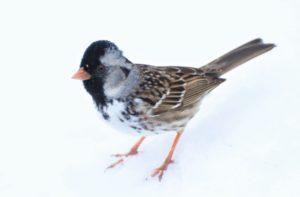
Fox Sparrow — With its striking cinnamon-colored back, stark white breast, and loosely organized rows of v-shaped arrowhead markings, the fox sparrow is one America’s most beautiful sparrows. Armed with talon-like claws that would do a raptor justice, the sparrow uses both feet to vigorously stir the forest floor. Leaves and litter fly high as the bird rakes the ground for seeds. Although most fox sparrows nest in Alaska and northern Canada, a few stragglers venture as far north as Iceland and Greenland – an amazing journey for sparrows that may have spent the winter months in southern Texas.
American tree sparrow – With its boisterous demeanor, rusty cap, central breast spot, and vivid white wing bars; the tree sparrow is one of the most beautiful members of its family. Tree sparrows nest in the subarctic and winter across the U.S. Ironically, the poorly named tree sparrow has little association with trees. Instead, they spend nearly all their time foraging and even nesting on the ground.
Chipping sparrow – Familiar visitors at backyard feeders, chipping sparrows are a common Iowa nester. Similar to tree sparrows in size and color, the chippie’s brilliant red cap is underscored by a bold white stripe. Chipping sparrows have a unique migration. When summer nesting is complete, adults fly to the tundras of northern Canada and Alaska for the summer molt. Once the annual change of feathers is complete, Chipping sparrows embark on a fall flight that may lead as far south as Guatemala and Honduras.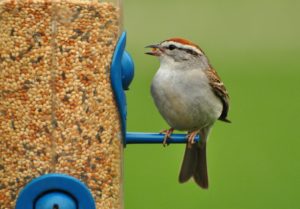
Slate-colored junco – One of the commonest Iowa birds during winter, the junco breeds in the northern Great Lakes region and throughout Canada. Many people are surprised to learn that the junco is a member of the sparrow clan.
White-throated sparrow – The sturdily built white-throated sparrow only occur s in Iowa as a migrant. They have a cheery song and are easily identified by their striking white throat patch and vivid yellow lores. Eager to reach far northern nesting areas, spring migrants are often caught in late season snowstorms.
s in Iowa as a migrant. They have a cheery song and are easily identified by their striking white throat patch and vivid yellow lores. Eager to reach far northern nesting areas, spring migrants are often caught in late season snowstorms.
Song sparrow – Abundant and widespread, the song sparrow is one of North America’s most plentiful native sparrows. Found in Iowa year-round, the russet striped bird is found in a variety of brushy habitats. At least a part of its abundance can be attributed to the fact that song sparrows may successfully produce three broods in a single season.
White-crowned sparrow – One of our most handsome sparrows, the energetic white-crowned may travel more than 3,000 miles between summer and winter homes. Migrating at night, white-crowns use celestial bodies to navigate, sometimes traveling hundreds of miles during a single flight.
The list of native sparrows continues. The take home is that, even though they are often overlooked and underappreciated, sparrows represent an incredibly diverse, fascinating and valuable grouping of wild birds.

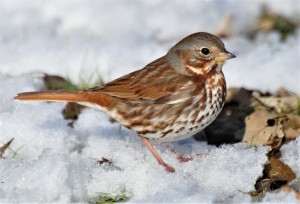

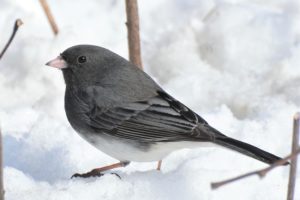

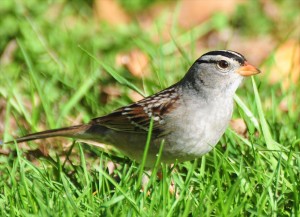
 Tom Cope
Tom Cope Sue Wilkinson
Sue Wilkinson Susan Judkins Josten
Susan Judkins Josten Rudi Roeslein
Rudi Roeslein Elyssa McFarland
Elyssa McFarland Mark Langgin
Mark Langgin Adam Janke
Adam Janke Joe Henry
Joe Henry Kristin Ashenbrenner
Kristin Ashenbrenner Joe Wilkinson
Joe Wilkinson Dr. Tammy Mildenstein
Dr. Tammy Mildenstein Sean McMahon
Sean McMahon